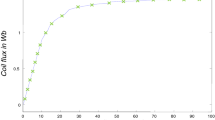Contents
The objective of an AC-to-DC converter is to control the output waveform. The energy emanated from the source is adapted by passive filters, which is often a compromise between volume and effective use. A classical rectifierfilter network presents a major disadvantage: a power factor less than one which is caused by distortion of the source current.
The resolution of the high-frequency input current of the series-resonant converter introduces the possibility of controlling the waveform of the source current accurately. In combination with the accurate positioning of the high-frequency current pulses, it is possible to influence the exchange of power with the source by the introduced method of active filtering. A power factor equal to one would lead to an optimal operation. The method introduced can select any value for the power factor, even for distorted voltage waveforms.
However the zero-crossing of the AC source voltage introduces the necessity of storing energy. Bulky low-frequency storage elements increase the specific volume and weight of the converter while the exchange of energy with storage elements decreases the overall efficiency. The energy stored in the resonant circuit is fundamentally too low to solve this problem. The stored energy in the output capacitor, necessary to decrease the high-frequency ripple voltage, is available for these purposes. To meet the optimal conditions for the power factor at the source, a bipolar flow of energy is required.
The theory of single-phase AC-to-DC series-resonant power conversion with controllable reactive power is explained. The results of simulation and experiment will establish the extensive possibilities of the proposed systems.
Übersicht
Die Aufgabe eines AC-DC Umrichters ist es, die Spannungsform des Ausganges regelungstechnisch festzulegen. Die von der Speisequelle entnommene Energie wird über passive Filter ausgekoppelt, die stets einen Kompromiß zwischen Raumbedarf und erzielter Wirkung bilden. Ein klassischer Gleichrichter liefert, besonders, wenn er gesteuert ist, stets einen netzseitigen Leistungsfaktor, der kleiner eins ist. Dies ist durch den verformten und in der Phase verschobenen Netzstrom bedingt.
Die hohe Auflösung des hochfrequenten Eingangsstromes eines serienresonanten Umrichters bietet die Möglichkeit, die netzseitige Stromform sehr genau zu regeln. In Verbindung mit der genauen Positionierung der hochfrequenten Strompulse ist es möglich, die momentan zugeführte Energie mit der vorgestellten Methode der aktiven Filterung zu beeinflussen. Ein geregelter Leistungsfaktor von eins führt so zu einem optimalen Betriebszustand. Die vorgesehene Methode gestattet es, jeglichen Leistungsfaktor einzustellen, selbst bei einer pulsierenden Spannungszeitfunktion.
Der Nulldurchgang der Wechselspannung des Netzes zeigt die Notwendigkeit, Energie zwischenzeitlich zu speichern. Speicher für niedrige Frequenzen erhöhen das Gewicht und das Volumen des Umrichters, gleichzeitig läßt der Austausch von Energie mit Energiespeichern den Wirkungsgrad sinken.
Die gespeicherte Energie in einem hochfrequenten Resonanzkreis ist also grundsätzlich zu gering, um dieses Problem zu lösen. Die gespeicherte Energie dagegen in den erforderlichen Ausgangsfilter-Kondensatoren, die zur Glättung der Spannung dienen, ist für diesen Zweck gut geeignet. Um optimale Bedingungen hinsichtlich des netzseitigen Leistungsfaktors zu erhalten, ist ein Leistungsfluß in beiden Richtungen erforderlich.
Die Theorie eines einphasigen AC-DC serienresonanten Umrichters mit regelbarem Leitungsfaktor wird erläutert. Simulationen und Meßresultate einer derartigen Ausführung werden vorgestellt, die die weiten Möglichkeiten einer Leistungsflußregelung verdeutlichen.
Similar content being viewed by others
References
Schwarz, F. C.: A time-domain analysis of the power factor for a rectifier filter system with over-and subcritical inductance. IEEE Trans. Ind. Electron. Control Instrum. 20 (1973) 61–68
Schwarz, F. C. and Klaassens, J. B.: A reversible smooth current source with momentary internal response for nondissipative control of multikilowatt de machines. IEEE Trans. Power Appar. Syst. 100 (1981) 3008–3016
Klaassens, J. B., Smits, E. J. F. M.: Series-resonant ac-power interface with an optimal power factor and enhanced conversion ratio. IEEE Power Electronics Specialists Conference June (1986) Vancouver Canada 39–48
Klaassens, J. B.: DC-to-AC Series-Resonant Converter System With High Internal Frequency Generating Synthesized Waveforms for Multikilowatt Power Levels. IEEE Trans. Power Electron. 1 (1986) 9–20
Klaassens, J. B., Moïze de Chateleux, W. L. F. H. A., van Wesenbeeck, M. P. N.: Phase staggering control of a series-resonant de-de converter with paralleled power modules. IEEE Trans. Power Electron. 3 (1988) 164 bis 173
Klaassens, J. B., van Duivenbode, J.: Series-resonant energy conversion with multi-segment current waveforms for bipolar energy flow. IEEE Power Electron. Special. Conf. Kyoto (1988) 599–608.
Destobbeleer, E., Seguier, G., Castelain, A.: AC-DC Converter Minimizing Induced Harmonics in Industrial Power Systems. IEEE Trans. Power Electron.2 (1987) 320–327
Tironi, E., Zaninelli, D., Ubezio, G.: Compensation of the reactive power by means of a current-controlled transistor inverter. Second European Conf. Power Electron. Appl. Grenoble (1987) 1293–1299
van Schoor, G. and van Wijk, J. D.: A Study of a system of current fed converters as an active three phase filter. IEEE Power Electron. Special. Conf. Blacksburg (1987) 482–490.
Kalyan Kumar Sen: Unity Power Factor operation of Single-phase Converters. Ph.D Thesis Worcester Polytechnic Institut. May 1987
Dixon, Lloyd, H.: High Power Factor Preregulators. Power Electron. 35 42–50
Author information
Authors and Affiliations
Rights and permissions
About this article
Cite this article
Klaassens, J.B., van Wesenbeeck, M.P.N. & Lauw, H.K. Source-sided power flow control of a single-phase AC-to-DC series-resonant power supply. Archiv f. Elektrotechnik 74, 43–51 (1990). https://doi.org/10.1007/BF01573230
Received:
Issue Date:
DOI: https://doi.org/10.1007/BF01573230




